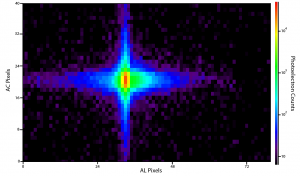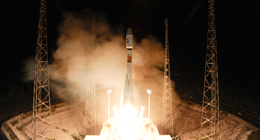It is probably hard to overestimate the effort required to coordinate the Gaia hardware and software development. While the industrial consortium EADS-Astrium developed the actual satellite and onboard software, the Data Processing and Analysis Consortium (DPAC) is responsible for the scientific data processing. As explained in an earlier blog entry, DPAC consists of several hundred people in dozens of scientific institutes spread all over Europe. Because the scientific requirements of the Gaia measurements are on the edge of what seems physically possible, every aspect of the hardware must be understood and calibrated to an unprecedented level – I will give an example below. This has led to a constant exchange between scientists and engineers: the scientists often requesting very stringent limits on hardware response (no ‘unwanted’ behaviour!) and the engineers trying to meet the demands by developing new hardware or tweaking the existing one.
Radiation damage testing
During my PhD studies I have been involved in some scientific tests that have led to changes in the way the satellite will be operated and calibrated. Being a scientist myself I have been on the ‘demanding side’, which concretely meant that we requested Astrium to test the detailed behaviour of the Gaia cameras due to ‘radiation damage’.
This ‘damage’ is done by fast protons that are expelled by the Sun during solar flares, and which follow non-straight trajectories through the Solar System. They enter the satellite not only through the telescope openings but can also fly through thin parts of the satellite, like the sunshield. When they collide with the atomic lattice of the CCD cameras they can cause tiny defects, which distort the images that Gaia captures. The cameras are designed to be quite resilient against this kind of damage, but during several years the effect will accumulate to a level that could affect the quality of the data. Therefore tests were needed to estimate how large the effect could potentially be.
Astrium took a real (spare!) Gaia CCD and irradiated part of it in a proton beam to mimic an expected 5-year dose. Then they built a ‘test bench’ that mimics the observation of stars on that CCD. The results of this test campaign were scrutinised by us, and as you often will hear at the end of a scientific talk: we wanted more data. A period of several years followed where there was an exchange of requests and new tests from Astrium, which resulted in several different test campaigns covering all kinds of different aspects of the CCD behaviour due to radiation damage. Since we have not seen real Gaia data yet, it is unclear how large the effect of radiation damage will be in reality. But once we see signs of it, we might already have a pretty good understanding of how to handle it!
The below movie shows a simulation of how radiation damage can affect Gaia measurements.
Extraordinary requirements
During this period I realised that it is very easy to find something to complain about, but also that it is quite extraordinary that the engineers have been able to design and build a full satellite that – according to all tests – can achieve the dazzling requirements that we set out for it!
Imagine you are asked to build:
- a four-metre size machine with a foldable ten-metre size sunshield that needs to be launched into space,
- that spins at a rate of 60 degrees per hour with deviations smaller than 0.01%,
- that has the largest focal plane ever flown in space, having about 100 cameras that should produce so little noise that even a star image for which only several hundred photons are received can be measured with enormous clarity (these are the faintest, but most abundant stars that Gaia will measure),
- while it should also be able to measure stars 1 million times brighter,
- measure simultaneously their colour,
- and if they are not too faint: take their spectrum.
… Oh, and please do that for 1 billion objects, which is 10,000 times more than Gaia’s predecessor: the Hipparcos satellite. Ah, and before I forget: to do this you will need two mirrors of 1.5 metres (compared to 29 cm for Hipparcos) and they should stay aligned within an angle that is smaller than that of a coin on the Moon seen from Earth!
Well, the amazing engineers at EADS-Astrium seem to have done just that, and it is not hard to imagine that we now cannot wait for the launch!
And when you feel dazzled by all these numbers you can just remember the following: compared to our naked eye Gaia will observe a million times more objects, up to a million times fainter and a million times sharper – now that sounds like science on the edge of the possible to me!
This entry was submitted by Berry Holl, member of the Gaia Data Processing and Analysis Consortium.



Discussion: no comments